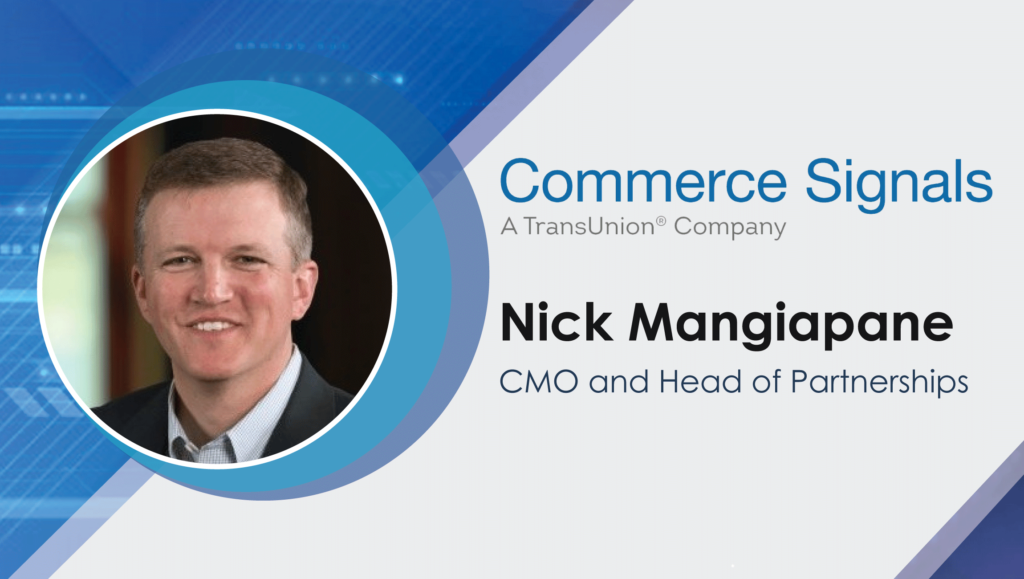Nick Mangiapane, CMO and Head of Partnerships at Commerce Signals discusses the future trends that will impact online and offline retail strategies in this catch-up with SalesTechStar:
________
Welcome to this SalesTechStar chat Nick, tell us about yourself and your role at Commerce Signals…what inspires you about the B2B tech market?
Hi! Thanks for having me. I spent most of my career as a consumer products marketer before joining Commerce Signals as CMO six years ago. Commerce Signals unrivaled access to credit and debit card transaction data for consumer and retail marketing uses is what did and still does get me excited about my job. We help marketers make better, data-based decisions by combining great data with simple math. The combo is easy to understand and explain to other execs.
The rate of change in B2B tech is amazing, but it offers opportunities and challenges for marketers. There are so many, ever-changing companies and capabilities that it’s impossible for anyone to know it all – nevermind when you have a day job that is running the business. I’ve been there. My team and I try to focus everything we produce on why an advertiser should care. There’s no time to waste.
Read More: SalesTechStar Interview with Greg Arnold, Vice President of Engineering for LinkedIn Sales Solutions
We’d love to hear about Commerce Signals and how it’s evolved as a platform over the years?
Our first product was sales lift measurement. We’d connect ad impressions to card transaction data so you know what marketing drives sales in an aggregated, privacy friendly way. Since then, we’ve developed a complete suite of complementary products that includes customer insights, data enrichment, audiences and we now have multiple measurement solutions. We were acquired by TransUnion last year and are excited about unlocking product and commercial synergies moving forward.
When it comes to retailers today, how can they leverage transactional data to better understand where customers buy to find opportunities for growth and competitive advantage outside their stores?
Most retailers don’t know who all their customers are. They know their loyalty members and their online buyers, but that leaves a gap of 60-70% of shoppers for many brick and mortar retailers.
We can fill that huge knowledge gap in identity as well as in where their customers shop when they are not buying from them. This is key to understanding “share of wallet”, which is a true measure of loyalty. Competitive shopping behavior also allows for headroom analysis which uncovers opportunities and efficiency gains. Understanding your shoppers better than your competition is a competitive advantage. Just look at Amazon…
What can digital retailers do more of to drive online experiences and journeys?
Relevance is key when trying to gain consumers attention and consideration. Personalization is one way that digital retailers try to achieve relevance. The challenge is that relying solely on first-party data means most site visitors don’t get a customized experience. Trusted third-party data sources, such as card purchase data, can be used to augment DTC first-party data allowing retailers to get more from their personalization efforts.
Can you talk about some of the best online journeys by B2C/B2B brands you’ve come across and what takeaways readers should keep in mind with regards to them?
Brands that value and implement data-driven outcomes are those who have the best customer journey. However, not all data is created equally.
Those brands that select the right partner to best service their needs are those that offer scale, all encompassing representation of customers and accuracy. Brands that utilize their own first-party data and layer with validated third-party data are those who understand their consumer better than the competition and are able to connect across all touchpoints of the consumer’s journey.
Read More: 8 Retail Innovation Trends Explored at the – Retail Technology Show 2023
Can you highlight more about the future of the B2B tech market and in what ways you expect to see it grow?
Clearly we are on the cusp of a wave of AI tech focused on business use. Whether it’s writing copy, status reports, identifying issues or routine accounting, AI has game changing potential. What won’t change is that confidential, regulated data like payments won’t be ubiquitous or available to ChatGPT like functions. It takes years to work with a single bank to unlock data while protecting individual privacy. That’s ultimately why Commerce Signals was founded, to unlock buying signals in purchase data.

Commerce Signals connects advertisers and publishers directly with near-real-time insights from financial institutions. Advertisers use these insights to optimize media tactics and measure the incremental cross-channel sales driven by their advertising.
Nick Mangiapane is the Chief Marketing Officer and Head of Partnerships for Commerce Signals. He has a broad range of marketing and product experience in both B2C and B2B companies including Procter & Gamble, Newell Rubbermaid, and Ingersoll Rand. He earned his MBA from Cornell University and his bachelor’s in Finance and Operations from Boston College.
Missed The Latest Episode of The SalesStar Podcast? Have a quick listen here!
Episode 165: Why You Need Video In your Sales and Marketing Outreach: with Karthi Mariappan, Co-founder and CEO at Hippo Video
Episode 164: The Growth of Digital Experience Platforms with Darren Guarnaccia, president of Uniform
Episode 163: The Benefits of Video in Sales, Marketing, HR and more with Jonathan Lister, COO at Vidyard





















